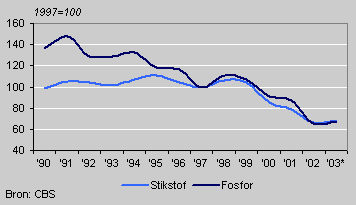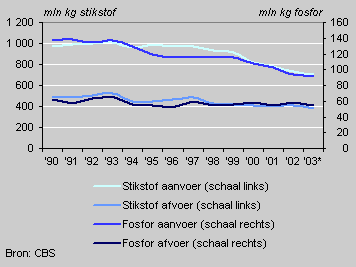Mineral surplus in agriculture drops sharply

The national mineral surplus on farmland has dropped substantially since the introduction of the official notification system (MINAS) in 1998. According to figures for 2002, the surplus of both nitrogen and phosphor were about one third smaller than in 1997. Provisional figures show that the surpluses did not fall further in 2003.
Mineral surplus on farmland

Less nitrogen
The notification system MINAS seems to have had a positive effect on the surplus of nitrogen in particular. Following a short-lived decrease at the end of the eighties, the nitrogen surplus hardly changed for years. Only after the introduction of MINAS did this surplus start to decrease again. In 2002 the nitrogen surplus was 34 percent lower than in 1997.
The reduction of the phosphor surplus started at the end of the eighties, as the mineral policy at the time was mainly aimed at phosphor. In 2002 the phosphor surplus was 35 percent smaller than in 1997 and more than 50 percent smaller than in 1990. In 2003 the input through cattle feed deceased further, but as the removal was also smaller the surplus did not fall further.
Nitrogen and phosphor balance

Smaller input of manure and artificial fertilisers
The reduction of the surpluses is the result of the smaller input of minerals in the ground through both manure and artificial fertilisers. Between 1990 and 2003 the input of nitrogen fell by 27 percent, that of phosphor by 34 percent.
The removal of phosphor has remained about the same level through the years. In the period 1990-2003 the average was just under 60 million kg. However for nitrogen the removal decreased, curbing the reduction of the nitrogen surplus. The removal of nitrogen with grassland products in particular has decreased (by 30 percent compared with 1990). The lower nitrogen input results in a smaller grass production, and in a lower nitrogen content of this grass; moreover the area of grassland has also decreased.
Kees Olsthoorn and Norma Fong